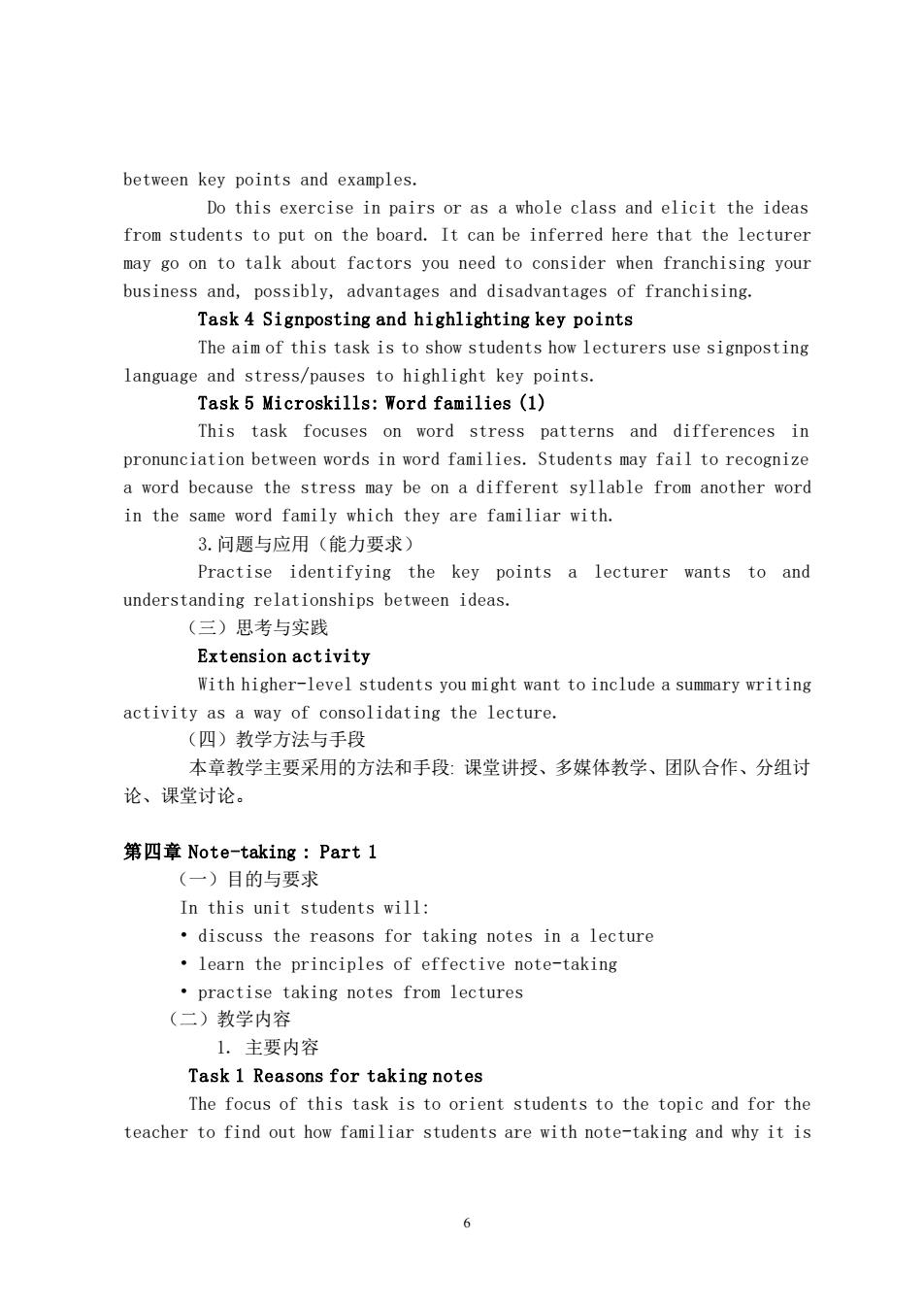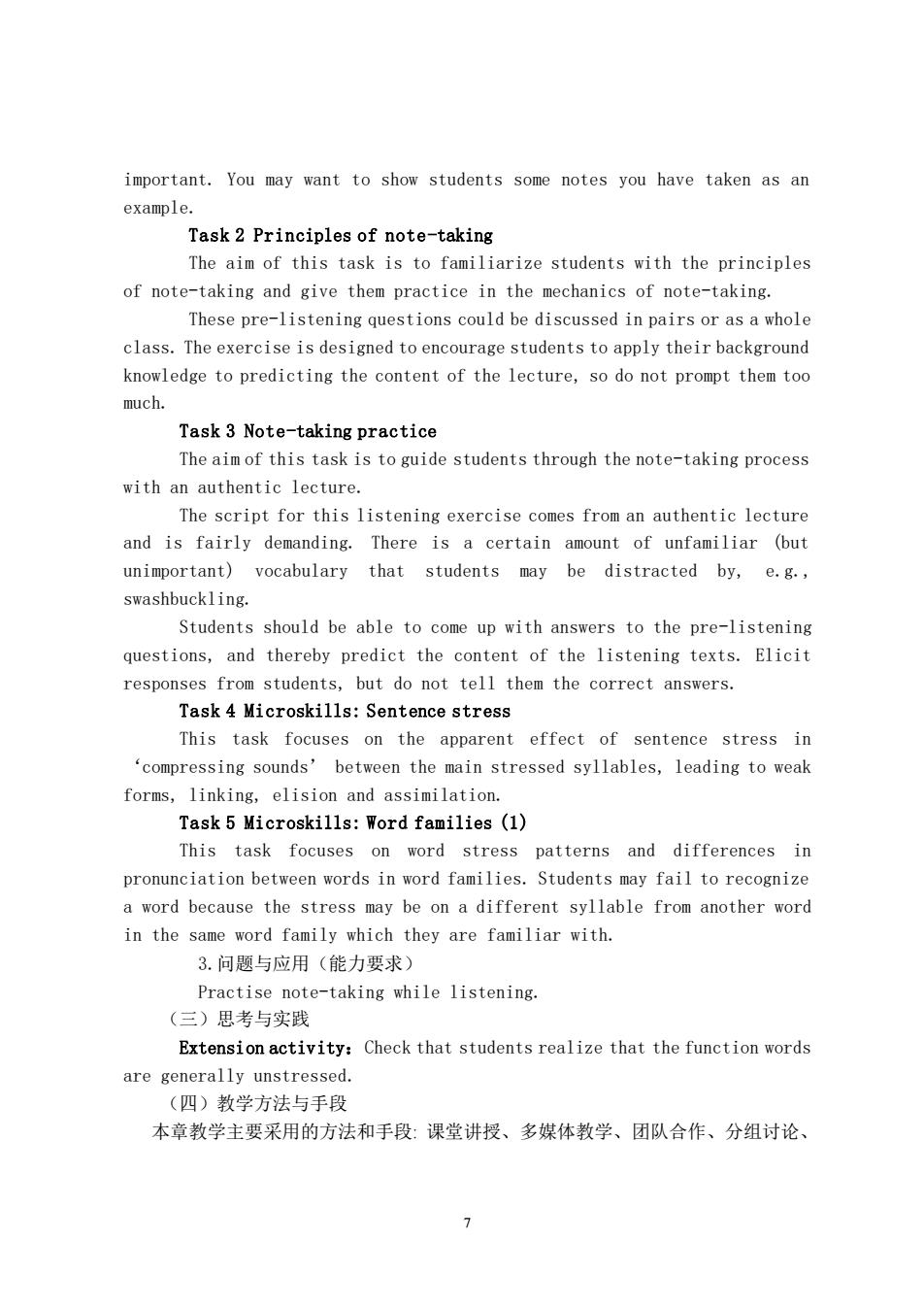
between key points and examples. Do this exercise in pairs or as a whole class and elicit the ideas from students to put on the board.It can be inferred here that the lecturer may go on to talk about factors you need to consider when franchising your business and,possibly,advantages and disadvantages of franchising. Task 4 Signposting and highlighting key points The aim of this task is to show students how lecturers use signposting language and stress/pauses to highlight key points. Task 5 Microskills:Word families (1) This task focuses on word stress patterns and differences in pronunciation between words in word families.Students may fail to recognize a word because the stress may be on a different syllable from another word in the same word family which they are familiar with. 3.问题与应用(能力要求) Practise identifying the key points a lecturer wants to and understanding relationships between ideas. (三)思考与实践 Extension activity With higher-level students you might want to include a summary writing activity as a way of consolidating the lecture. (四)教学方法与手段 本章教学主要采用的方法和手段:课堂讲授、多媒体教学、团队合作、分组讨 论、课堂讨论。 第四章Note-taking:Part 1 (一)目的与要求 In this unit students will: discuss the reasons for taking notes in a lecture learn the principles of effective note-taking practise taking notes from lectures (二)教学内容 1.主要内容 Task 1 Reasons for taking notes The focus of this task is to orient students to the topic and for the teacher to find out how familiar students are with note-taking and why it is 6
6 between key points and examples. Do this exercise in pairs or as a whole class and elicit the ideas from students to put on the board. It can be inferred here that the lecturer may go on to talk about factors you need to consider when franchising your business and, possibly, advantages and disadvantages of franchising. Task 4 Signposting and highlighting key points The aim of this task is to show students how lecturers use signposting language and stress/pauses to highlight key points. Task 5 Microskills: Word families (1) This task focuses on word stress patterns and differences in pronunciation between words in word families. Students may fail to recognize a word because the stress may be on a different syllable from another word in the same word family which they are familiar with. 3.问题与应用(能力要求) Practise identifying the key points a lecturer wants to and understanding relationships between ideas. (三)思考与实践 Extension activity With higher-level students you might want to include a summary writing activity as a way of consolidating the lecture. (四)教学方法与手段 本章教学主要采用的方法和手段: 课堂讲授、多媒体教学、团队合作、分组讨 论、课堂讨论。 第四章 Note-taking : Part 1 (一)目的与要求 In this unit students will: • discuss the reasons for taking notes in a lecture • learn the principles of effective note-taking • practise taking notes from lectures (二)教学内容 1. 主要内容 Task 1 Reasons for taking notes The focus of this task is to orient students to the topic and for the teacher to find out how familiar students are with note-taking and why it is

important.You may want to show students some notes you have taken as an example. Task 2 Principles of note-taking The aim of this task is to familiarize students with the principles of note-taking and give them practice in the mechanics of note-taking. These pre-listening questions could be discussed in pairs or as a whole class.The exercise is designed to encourage students to apply their background knowledge to predicting the content of the lecture,so do not prompt them too much. Task 3 Note-taking practice The aim of this task is to guide students through the note-taking process with an authentic lecture. The script for this listening exercise comes from an authentic lecture and is fairly demanding.There is a certain amount of unfamiliar (but unimportant)vocabulary that students may be distracted by,e.g., swashbuckling. Students should be able to come up with answers to the pre-listening questions,and thereby predict the content of the listening texts.Elicit responses from students,but do not tell them the correct answers. Task 4 Microskills:Sentence stress This task focuses on the apparent effect of sentence stress in 'compressing sounds'between the main stressed syllables,leading to weak forms,linking,elision and assimilation. Task 5 Microskills:Word families (1) This task focuses on word stress patterns and differences in pronunciation between words in word families.Students may fail to recognize a word because the stress may be on a different syllable from another word in the same word family which they are familiar with. 3.问题与应用(能力要求) Practise note-taking while listening (三)思考与实践 Extension activity:Check that students realize that the function words are generally unstressed. (四)教学方法与手段 本章教学主要采用的方法和手段:课堂讲授、多媒体教学、团队合作、分组讨论
7 important. You may want to show students some notes you have taken as an example. Task 2 Principles of note-taking The aim of this task is to familiarize students with the principles of note-taking and give them practice in the mechanics of note-taking. These pre-listening questions could be discussed in pairs or as a whole class. The exercise is designed to encourage students to apply their background knowledge to predicting the content of the lecture, so do not prompt them too much. Task 3 Note-taking practice The aim of this task is to guide students through the note-taking process with an authentic lecture. The script for this listening exercise comes from an authentic lecture and is fairly demanding. There is a certain amount of unfamiliar (but unimportant) vocabulary that students may be distracted by, e.g., swashbuckling. Students should be able to come up with answers to the pre-listening questions, and thereby predict the content of the listening texts. Elicit responses from students, but do not tell them the correct answers. Task 4 Microskills: Sentence stress This task focuses on the apparent effect of sentence stress in ‘compressing sounds’ between the main stressed syllables, leading to weak forms, linking, elision and assimilation. Task 5 Microskills: Word families (1) This task focuses on word stress patterns and differences in pronunciation between words in word families. Students may fail to recognize a word because the stress may be on a different syllable from another word in the same word family which they are familiar with. 3.问题与应用(能力要求) Practise note-taking while listening. (三)思考与实践 Extension activity:Check that students realize that the function words are generally unstressed. (四)教学方法与手段 本章教学主要采用的方法和手段: 课堂讲授、多媒体教学、团队合作、分组讨论